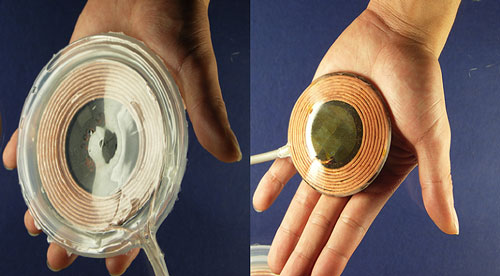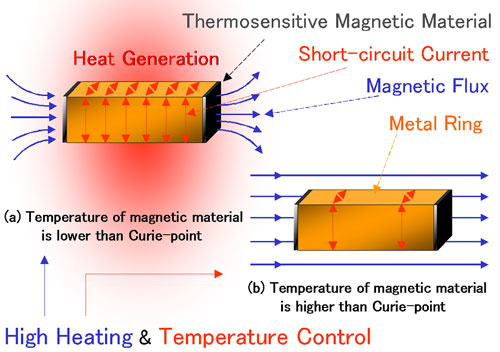HOME > Research Summaries > Medical Applications for Implantable Devices Utilizing Electromagnetic Fields
Research Summaries

Medical Applications for Implantable Devices Utilizing Electromagnetic Fields
Hidetoshi Matsuki
Department of Biomedical Engineering, Graduate School of Biomedical Engineering
E-mail:![]()
Abstract
We are examining the in vivo application of electromagnetic fields with regard to biomagnetism and energy management. From the perspective of electrical engineering, the power source of equipment is an important issue for the majority of medical devices. We approached various researches, which contain developments of functional hyper-thermia, thermotherapy by using metallic stent, FES system, transcutaneous power-signal supply system for implantable devices (artificial heart and rechargeable cardiac pacemaker), and temperature control for SMA artificial anal sphincter.
1. Introduction
We are examining the in vivo application of electromagnetic fields with regard to biomagnetism and energy management. From the perspective of electrical engineering, the power source of equipment is an important issue for the majority of medical devices. Power savings (i.e., low power consump-tion) and the use of wireless equipment hold the key to promoting the widespread use of medical equipment in a variety or areas, including social welfare and nursing. The next generation of electrical equipment should not need to be connected directly to a power source. Contactless power transfer will benefit medical equipment. When such equipment can be mounted to a device with no internal energy source, a dramatic improvement of the health system is envisioned. We expect such equipment to contribute greatly to medical treatment in the 21st Century. Medical equipment that constitues a fully self-contained system with non-contact energy transmission includes the following:
Type A: Uses transferred energy to power implaned devices, such as artificial hearts and micromachines;
Type B: Uses electrical power, such as in Functional electrical Stimulation Systems; and
Type C: Uses a heat source, such as in devices that produce local hyperthermia.
From the viewpoints, We approached various researches, which contain developments of functional hyperthermia system, thermotherapy by using metallic stent, FES system, transcutaneous power-signal supply system for implantable total artificial heart, power supply system for a rechargeable cardiac pacemaker, and temperature control for SMA artificial anal sphincter.
2. Applications
2.1. Transferred energy to power implanted devices
We studied an electric power transmission system for implanted medical devices, such as artificial hearts and rechargeable cardiac pacemakers. Figure 1 shows our Transcutaneous energy transmission system (TETS) for the implantable artificial heat. The transmission efficiency of our system achieves top level in the world.
In implanted medical devices, it is important to drive and communicate device control and monitoring signals across the skin for its stable operation. We examined improvements to transmission efficiency, using a magnetic field simulator, and fabricated a prototype charger system that has 50% efficiency for the rechargeable cardiac pacemaker.

left:(a) External Coil right:(b) Internal Coil
Fig.1 A pair of disklike coils for transcutaneous energy transmission system.
2.2. Functional electrical stimulation system
We have proposed a new contactless power-signal transmission device using electromagnetic coupling for a Functional Electrical Stimulation (FES) system, which consists of two coils in our study.
Our approach is based on a structure to implement a simultaneous power-signal transmission system, which enables power and signal for muscle stimulation to be concurrently transferred from outside the body, while allowing for the separation inside. The implanted FES system we designed consists of two sets of coils; one mounted outside and the other located inside the body. That is, this system employs an electromagnetic coupling to transmit not only signals to muscles but driving power, at the same time by a non-contact method.
2.3. Hyperthermia system
Hyperthermia induces tumor necrosis by the use of heat. It is generally well known that at temperatures in excess of 42.5 oC, the survival rate of tumor tissues drops sharply. In addition, the temperature of tumor tissues easily rises compared to that of normal cells, due to a higher heat sensitivity and a smaller cooling effect of blood flow, which then leads to advantages in using the hyperthermia.
The soft heating method is one of the hyperthemia. The heater that consists of thermosensitive ferrite is implanted into the body, and heated by high-frequency magnetic field. The source of heat is the hysteresis loss of the ferrite.
Our study applies the “advanced” soft heating method. We create a complex type of heater composed of thermosensitive ferrite wound on a metallic ring. This complex type of heater produces a higher heat due to losses of hysteresis and short-circuit current than thermosensitive ferrite alone. This heater makes tumor necrotized completely and locally.
Fig.2 displays the heating mechanism of the element. When the temperature of the thermosensitive magnetic material is lower than the the curie point (Tc), the magnetic flux is concentrated by the effect of high permeability of the magnetic material. The short-circuit current is then induced in the copper ring to raise the temperature of the heat element. On the other hand, when the temperature of the thermosensitive magnetic material is higher than the Curie point, the density of the magnetic flux disappears, thus resulting in loss of heat generation. Since the temperature of the heat element does not rise more than that of the Curie point, temperature control is achieved with the use of a Curie point as criteria.

Fig.2 Mechanism generating heat in hybrid heater.
3. Conclusion
These applications are assumed to be fully self-contained and the technology is based on the provision of non-contact energy transfer. To transmit energy without contact, it is thought best to utilize electromagnetic fields in order to achieve high energy density and efficiency.
Acknowledgment
Hidetoshi Matsuki acknowledges the support of Tohoku University Global COE Programme "Global Nano-Biomedical Engineering Education and Research Network Centre".
References
[1] Matsuki H, et al. IEEE Trans Magn 31, 1276-1282, 1995.
[2] Kakubari Y, Sato F, Matsuki H, et al. J Magn Soc Jpn 30, 510-514, 2006.
[3] Sato F, Matsuki H, et al. IEEE Trans Magn 40, 2964-2966, 2004.
[4] Takura T, Sato F, Matsuki H, et al. J Magn Soc Jpn 31, 288-292, 2007.